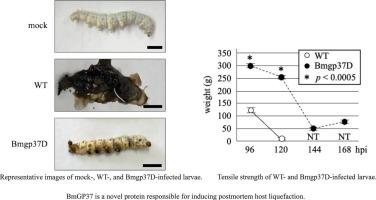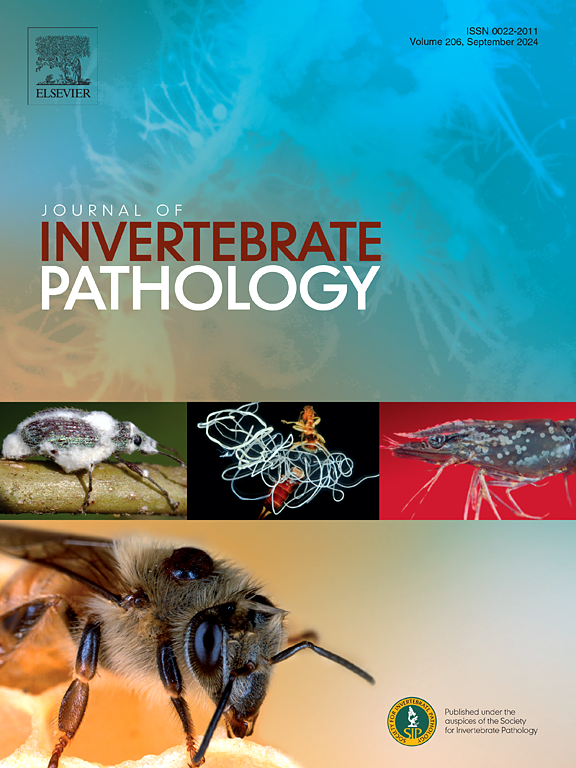Involvement of Bombyx mori nucleopolyhedrovirus GP37 in the postmortem host liquefaction
IF 2.4
3区 生物学
Q1 ZOOLOGY
引用次数: 0
Abstract
GP37, a component protein of baculovirus particles, enhances the ability of occlusion-derived virions (ODV) to penetrate the peritrophic membrane of host insects. The GP37 of Bombyx mori nucleopolyhedrovirus (BmNPV Orf52, Bm52) localizes to the mitochondria of host cells throughout the course of infection. However, the specific role of BmNPV GP37 (BmGP37) within infected cells and larvae remains unclear. In this study, to investigate the function of BmGP37, a Bmgp37-deleted virus (Bmgp37D) was constructed by inserting an hsp70-lacZ cassette. No significant differences were found between Bmgp37D and the wild type virus (WT) in terms of viral genome replication or virulence in cultured cells. However, both LC50 and LD50 values of Bmgp37D were higher in B. mori larvae compared to those of WT, and the LT50 of Bmgp37D was significantly longer than that of WT. Notably, postmortem liquefaction, crucial for the environmental release of occlusion bodies, was severely lessened in Bmgp37D −infected larvae. Expression levels of viral chitinase and viral cathepsin, both of which are associated with larval disintegration, showed no significant difference between Bmgp37D and WT. Similarly, systemic infection levels did not differ between Bmgp37D and WT. These findings indicate that BmGP37 is a novel protein required for postmortem host liquefaction.

家蚕核多角体病毒GP37参与死后宿主液化
GP37是杆状病毒颗粒的一种组分蛋白,可增强封闭衍生病毒粒子(ODV)穿透宿主昆虫营养膜的能力。家蚕核多角体病毒(BmNPV Orf52, Bm52)的GP37在整个感染过程中定位于宿主细胞的线粒体。然而,BmNPV GP37 (BmGP37)在感染细胞和幼虫中的具体作用尚不清楚。为了研究BmGP37的功能,本研究通过插入hsp70-lacZ卡带构建BmGP37缺失病毒(Bmgp37D)。Bmgp37D与野生型病毒(WT)在培养细胞中的病毒基因组复制和毒力方面无显著差异。然而,Bmgp37D在家蚕幼虫中的LC50和LD50值均高于WT, LT50值明显高于WT。值得注意的是,Bmgp37D感染的家蚕幼虫的死后液化(对闭塞体的环境释放至关重要)严重降低。病毒几丁质酶和病毒组织蛋白酶的表达水平在Bmgp37D和WT之间没有显著差异。同样,Bmgp37D和WT之间的全身感染水平也没有差异。这些发现表明BmGP37是死后宿主液化所需的一种新型蛋白。
本文章由计算机程序翻译,如有差异,请以英文原文为准。
求助全文
约1分钟内获得全文
求助全文
来源期刊
CiteScore
6.10
自引率
5.90%
发文量
94
审稿时长
1 months
期刊介绍:
The Journal of Invertebrate Pathology presents original research articles and notes on the induction and pathogenesis of diseases of invertebrates, including the suppression of diseases in beneficial species, and the use of diseases in controlling undesirable species. In addition, the journal publishes the results of physiological, morphological, genetic, immunological and ecological studies as related to the etiologic agents of diseases of invertebrates.
The Journal of Invertebrate Pathology is the adopted journal of the Society for Invertebrate Pathology, and is available to SIP members at a special reduced price.

 求助内容:
求助内容: 应助结果提醒方式:
应助结果提醒方式:


